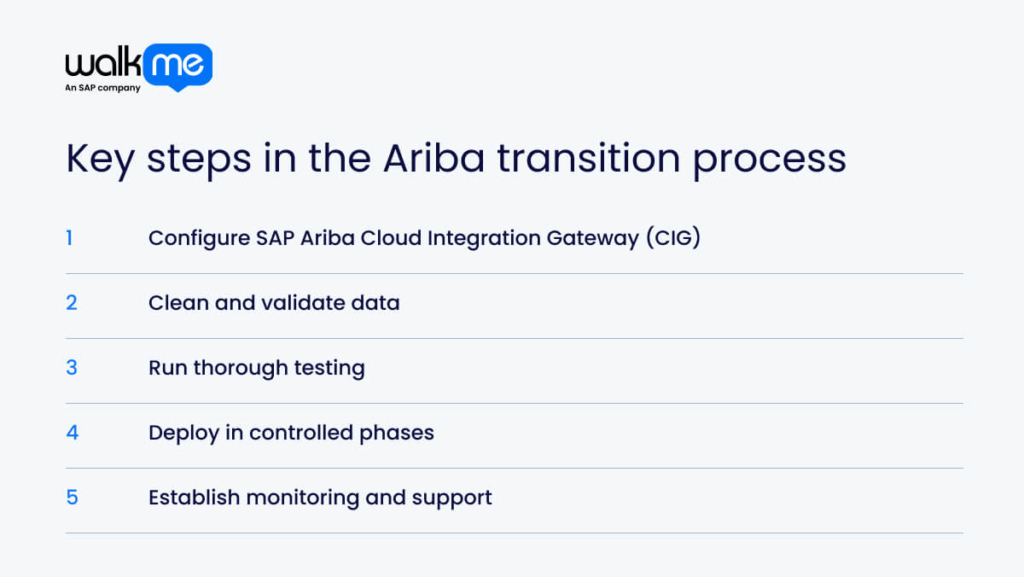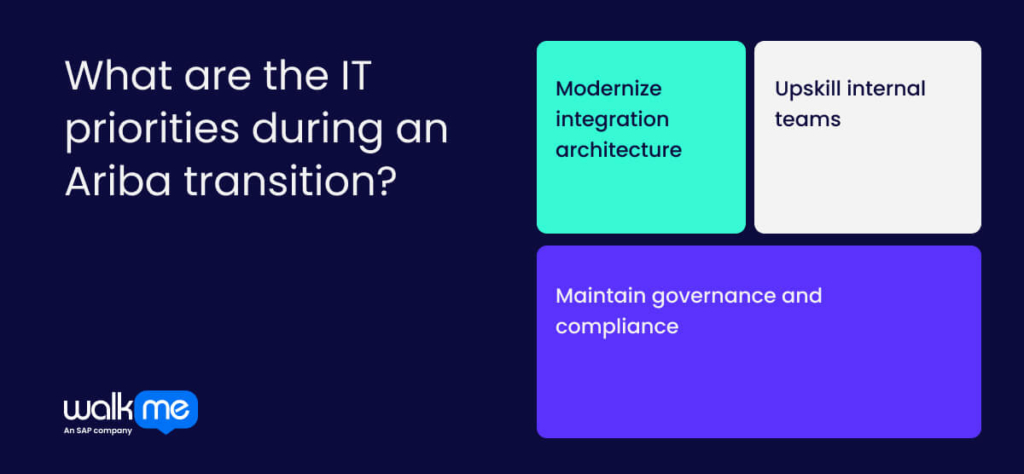A manual procurement process causes delays and wastes time. These delays can triple project timelines and hurt the business. Long contract reviews and compliance checks add more time. Poor communication makes it hard for teams to work with suppliers and each other. Teams spend too much effort evaluating supplier performance and managing risks.
Strategic, automated procurement takes a better approach. Instead of cutting short-term costs, it focuses on long-term value. SAP Ariba supports this by using APIs, pre-built templates, and real-time collaboration tools to modernize procurement. It also boosts supply chain flexibility, helping companies manage risks and improve adaptability.
This guide explains what the Ariba transition is and shows how to prepare for it. It outlines each step and highlights what IT teams must do along the way. In the final section, the guide explores what the future looks like after completing the transition.
What is an Ariba transition?
An Ariba transition is the process of moving an organization’s procurement operations to SAP Ariba, a cloud-native platform. This platform automates the entire purchasing lifecycle, from requisitioning to invoice processing.
For instance, Ariba provides tools to manage suppliers, including onboarding, performance monitoring, and contract management. It also guides employees to use preferred suppliers and ensures compliance with company policies.
The Ariba transition requires integrating the new system with existing applications, such as an ERP, and migrating essential data, including purchase orders and contract details. It also focuses on improving processes by streamlining purchase order processing and invoice matching. By automating these tasks, Ariba increases efficiency, reduces errors, and helps organizations manage their procurement operations.
Preparing for an Ariba transition
When businesses prepare early for the SAP Ariba transition, they avoid problems and ensure a more straightforward setup.
They also get more value from the system. For example, Ariba can help speed up work, and teams who learn how to use them during the change get the most out of the system.
Here’s how you can prepare for the transition:
Audit your current integration environment
Auditing your current integration environment before starting an Ariba transition helps you spot issues early. You can find bottlenecks, security risks, and data errors that might disrupt the new setup.
Start by reviewing all existing data integrations and checking how they interact with other systems. Measure performance, check for delays, and fix slow processes. Test security to find and resolve weak points.
Next, assess data quality to ensure accuracy and consistency. Confirm compliance with industry standards. The final step will involve identifying your business needs, mapping data flows, and planning process changes.
Align with ERP and infrastructure strategy
Aligning an Ariba transition with your ERP and infrastructure strategy ensures an effective procurement process. Begin by planning the data migration from your current systems to Ariba, checking for accuracy and compatibility. Build APIs and interfaces that connect Ariba with your ERP to enable real-time data exchange.
In addition, map out business processes and define how Ariba supports them in conjunction with your ERP. Train users so they understand how both systems work together. Update your infrastructure to support SAP Ariba’s requirements. Set up tools and processes to monitor performance and provide ongoing support. This approach reduces disruptions and helps you get the most out of it.
Design a modern integration model
A strong technology integration model allows data to move accurately between systems. This helps you avoid errors that disrupt your business. You can automate key tasks, such as purchase orders, invoices, and supplier management, by connecting Ariba with your ERP and other tools. This saves time, improves efficiency, and strengthens relationships with suppliers.
First, analyze your Source-to-Pay workflows and identify systems that need integration. Choose the right technologies, map data fields, and design processes that ensure smooth automation. Then, test everything to confirm it meets business needs. Use monitoring tools to track performance and quickly identify and fix issues. Lastly, train users on the changes to support long-term success.
Key steps in the Ariba transition process

Buyers, suppliers, and internal teams need to understand the steps in an Ariba transition to ensure a successful SAP Ariba setup.
When they know the process, they can communicate well, solve problems early, and get the full value from Ariba.
So, these are the steps you need to follow for an Ariba transition:
1. Configure SAP Ariba Cloud Integration Gateway (CIG)
The SAP Ariba Cloud Integration Gateway (CIG) connects Ariba with SAP ERP systems. It supports a better data exchange using tools like SAP Cloud Platform, CPI, and the CIG add-on.
First, install the add-on, configure the SAP Cloud Connector, and request that SAP enable CIG. Then, update your ERP settings, sync system info, and create CIG projects. Next, define connections, map data, and test the setup to ensure accurate data flow between systems.
2. Clean and validate data
To clean and validate data for an Ariba transition, first identify and fix incorrect, missing, or inconsistent entries. Apply clear validation rules to ensure the data matches system requirements.
In addition, use tools and scripts to automate tasks, reduce manual errors, and speed up the process. Ensure your team updates outdated information and confirms accuracy before proceeding with the next steps.
3. Run thorough testing
To test an SAP Ariba transition, focus on functional, performance, and integration testing, as well as user acceptance testing (UAT). Set up test environments and use predefined test cases. Include real users in UAT to identify issues.
Then, create detailed test cases to cover all aspects of the transition. Gather feedback from users, especially during UAT, to ensure Ariba meets their needs. Monitor Ariba’s performance after the transition and fix any emerging issues.
4. Deploy in controlled phases
Deploy SAP Ariba in phases to minimize disruption. Start by testing it with a small group of users or a department. Collect feedback to see how it works and adjust as needed. Track system performance and identify areas to improve. Gradually expand Ariba to other departments, using feedback to refine the system.
5. Establish monitoring and support
To set up monitoring and support for an SAP Ariba transition, focus on clear communication and detailed documentation. Use change management strategies and offer thorough training. Set up exception monitoring in SAP Cloud ALM. Have a support team ready to address any issues that arise.
What are the IT priorities during an Ariba transition?

IT teams must focus on the right priorities during an SAP Ariba transition to ensure a smooth and successful implementation.
They manage the technical work, protect data accuracy, and connect Ariba with existing systems.
Here are their priorities during this transition:
Modernize integration architecture
Modernizing the integration architecture during an Ariba transition is a strategic investment for the future of the supply chain. It improves flexibility, efficiency, and adaptability, leading to better procurement outcomes. This process involves updating from older integration methods to more flexible, modern approaches.
Creating reusable templates and setting development guidelines ensures consistency and scalability. In addition, standardizing processes and improving data quality enhances automation and improves data integrity. Modern integration architectures must also prioritize security with strong authentication and ensure compliance with industry regulations.
Upskill internal teams
Upskilling an IT team during an Ariba transition is essential for a successful implementation. This proactive approach increases user adoption and promotes learning agility within the IT department. A trained team also ensures a faster go-live process and helps avoid delays.
IT leaders can begin this process by identifying skill gaps based on roles and responsibilities. Then, create training programs specific to Ariba’s features, methods, and tools for each IT role. Next, provide hands-on practice through simulations or sandbox environments.
More importantly, offer continuous mentorship and resources to resolve issues. Focus on key areas like Ariba modules, data security, and troubleshooting.
Maintain governance and compliance
Maintaining an IT compliance and governance process during an SAP Ariba transition helps protect data and ensure adherence to regulatory standards. IT teams should begin by defining user roles and permissions to control access to sensitive data and functions. They should also identify and manage risks such as data breaches or fraud.
In addition, IT stakeholders must align Ariba with existing compliance policies to enforce company standards. Create and implement procurement guidelines, including contract and buying rules. Even more, set clear data standards and manage the full data lifecycle to keep information accurate and secure. Don’t forget to train users on how to use audit trails to track compliance and support reporting.
Trends shaping future Ariba transitions
Procurement and supply chain professionals must understand the trends shaping future Ariba transitions. These trends help them prepare for changes in how organizations use and integrate Ariba.
By staying ahead, they can adapt to new technology, improve their processes, and create more value.
These are the trends you need to look out for:
Embedded AI and automation
SAP Ariba will use AI and automation to improve procurement. It will automate tasks like contract creation and invoice matching. Teams will adopt embedded AI tools to analyze data to strengthen supplier chain management. In summary, AI will help businesses make faster, smarter decisions and run more efficient procurement operations.
Supply chain resilience
Your company will find it easier to adapt to changes, manage risks, and respond to market shifts. This is because SAP Ariba will make your supply chain more flexible and strong. The SAP Business Network solution enables companies to collaborate in real-time with supply chain partners, including service providers and logistics operators. This improves data visibility and strengthens business resilience.
Sustainability and ESG-driven procurement
In the future, SAP Ariba will help businesses integrate sustainable practices into their procurement processes. From sourcing to managing supplier performance, it can track environmental performance and evaluate suppliers on ESG risks.
Moreover, it supports the circular economy by encouraging recycling and resource efficiency. In addition, the platform enables collaboration with suppliers and provides data-driven insights to track progress toward ESG goals.
Deliver long-term enterprise procurement value with an Ariba transition
An Ariba transition is a big project that changes how a company handles procurement. It uses Ariba’s cloud platform to make processes faster, follow rules better, and improve work with suppliers. To succeed, you must manage the change well. Get support from top leaders and explain why the digital shift matters. Focus on getting systems ready, building the right skills, and setting clear rules.
Make sure the CFO and Chief Supply Chain Officer back the project. Bring in leaders from other departments too. Show how the IT project supports the company’s larger goals. With good planning, Ariba can reduce procurement risks. Keep the whole team involved and share the full vision to make the transition more effective.
FAQs
SAP Ariba uses the SAP Activate method for its implementation. This method has four main steps: Prepare, Explore, Realize, and Deploy.

